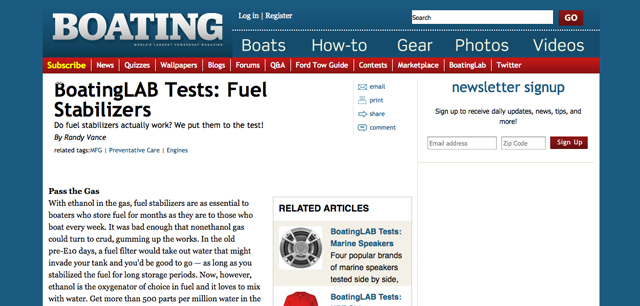BoatingLAB Tests: Fuel Stabilizers
Do fuel stabilizers actually work? We put them to the test! By Randy Vance
Click here to view post: http://www.boatingmag.com/how-to/preventative%20care/boatinglab-tests-fuel-stabilizers
Pass the Gas
With ethanol in the gas, fuel stabilizers are as essential to boaters who store fuel for months as they are to those who boat every week. It was bad enough that nonethanol gas could turn to crud, gumming up the works. In the old pre-E10 days, a fuel filter would take out water that might invade your tank and you’d be good to go — as long as you stabilized the fuel for long storage periods. Now, however, ethanol is the oxygenator of choice in fuel and it loves to mix with water. Get more than 500 parts per million water in the fuel, and it bonds with all the ethanol and then plops to the bottom of the tank in a powerless blob. That’s phase separation, and it takes the octane with it. If this crud even burns through the engine, it abrades injectors, nullifies the work of lubricants and causes catastrophic damage. It happens suddenly. A gallon of our test fuel turned into about three ounces of water/ethanol and 61 ounces of unusable 77-octane gasoline. That would have been nearly a half-gallon of the ethanol crud at the pickup of a 100-gallon tank. No wonder engines go bang.
How We Tested
For precision, and to work with quantities of fuel more suitable to a lab than a gas dock, we used metric, rather than U.S. liquid, volume measurement. We dosed 500 milliliters of untreated E10 fuel with excessive water to see how long it could hold off phase separation. Then we similarly overdosed eight 500-milliliter fuel samples, each of which was mixed with a different fuel treatment. To that treated fuel, we added water in 0.5-milliliter increments of 0.5, 1.0, 1.5, 2.0, 2.5, 3.0, 3.5, 4.0 and 5.0 milliliters and noted the results. Phase separation began for all treated samples at 2.5 milliliters–0.5 percent or 12,500 ppm, proving the efficacy of using stabilizers.So At the end of our test, an average 25 milliliters of crud — 5 percent of the fuel supply — sank to the bottom of the graduated cylinders we used for testing.
Goals and Findings
Our goal was to discover which fuel treatment, applied to 87 octane E10 fuel, could stave off phase separation most effectively. Some don’t specify an increase in the percentage of absorption. Some say it will double the absorbing quality of the fuel. We found very little difference between brands in preventing phase separation but did show definitively that fuel treatments can retard the process. We also compared costs and rated ease of use based upon the bottle’s method of providing a measuring device. Our test parameters did not include substantiating long-term oxidation prevention claims.
The Fix
New fuel stabilizers are formulated not just to stop varnishing, but also to mitigate the effects of phase separation. Lubrication is part of the mix too, and you can feel the viscosity of the fluids between your fingers. This is what helps lubricate parts and prevent corrosion, along with the ability of the products to retard phase separation and keep small amounts of water in suspension. If phase separation does occur in a tank, the process is immediate, complete and irreversible.
The Chemistry
Through conversing with chemists at ValvTect, we learned that E10 gas could absorb 500 ppm of water before phase separation. Add just a smidge more and the reaction is sudden, and though innocuous-looking in a graduated cylinder, the cloudy sludge is destructive to engines. This process is used to test the ethanol content of fuels. E10 can contain a maximum of 10 percent ethanol. It may have less. Our fuel undoubtedly did have less — perhaps 7 percent, judging from the amount needed to induce phase separation, and the percentage of volume that was phase-separated liquid at the end of the test.
Click here to view results: http://www.boatingmag.com/how-to/preventative%20care/boatinglab-tests-fuel-stabilizers
NOTE: AquoFusion | Gasoline Formula is now PetrolFusion
AquoFusion (now PetrolFusion) fuel treatment is touted to improve fuel efficiency, power and economy and stabilize fuel, preventing gumming and varnish that appear in unstabilized fuel. We couldn’t verify claims of performance improvements in engines, but our test showed it has the same ability to help retard phase separation in E10 fuel.


June 20, 2015 - 10:12 pm
… [Trackback]
[…] There you will find 22845 more Infos: nanofusionint.com/media/boatinglab-tests-fuel-stabilizers-boating-magazine/ […]